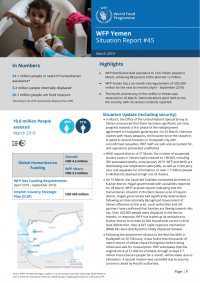WFP Yemen Situation Report #45, March 2019
In Numbers
24.1 million people in need of humanitarian assistance*
3.3 million people internally displaced
20.1 million people are food insecure
*According to the 2019 Humanitarian Response Plan (HRP)
Highlights
• WFP distributed food assistance to 10.6 million people in March, achieving 88 percent of the planned 12 million.
• WFP Yemen has a six-month net requirement of USD 609 million for the next six months (April – September 2019).
• The fourth anniversary of the conflict in Yemen was observed on 26 March. Demonstrations were held across the country, with no serious incidents reported.
Situation Update (including security)
• In March, the Office of the United Nations Special Envoy to Yemen announced that there has been significant, yet slow, progress towards a first phase of the redeployment agreement in Hudaydah governorate. On 25 March, intensive clashes with heavy weapons, the heaviest since the ceasefire, erupted in several locations in Hudaydah City with unconfirmed casualties. WFP staff are safe and accounted for, and operations proceeded unaffected.
• WHO reports that as of 27 March, the number of suspected cholera cases in Yemen had increased to 138,000, including 266 associated deaths, since January 2019. WFP and WHO are distributing oral rehydration salts (ORS), as well as 5 litre jerry cans and aquatabs for chlorination, to over 1.7 million people in 48 districts deemed at high risk of cholera.
• On 10 March, the Saudi-led Coalition conducted airstrikes in Kushar district, Hajjah governorate with causalities reported.
On 28 March, WFP received reports indicating that the humanitarian situation in the Bani Hassan area of Hayran district, Hajjah governorate had significantly deteriorated following an Internationally Recognized Government of Yemen offensive on the area. Local authorities and UN partners have confirmed that families are fleeing towards Abs city. Over 420,000 people were displaced in the last six months. In response, WFP has scaled up its assistance to Kushar district to include 22,000 households via the in-kind food distribution. Also, 8,647 rapid response mechanism (RRM) kits were distributed to newly displaced families.
• Following the assessment mission to the Red Sea Mills in Hudaydah on 26 February, it was found that thousands of metric tonnes of wheat require fumigation before being milled and safe for consumption. WFP anticipates that the original stock of 51,000 mt of wheat, enough to feed 3.7 million food insecure people for a month, will be lower due to infestation. A second mission was cancelled due to security concerns raised by Houthi authorities.
https://reliefweb.int/report/yemen/wfp-yemen-situation-report-45-march-2019


